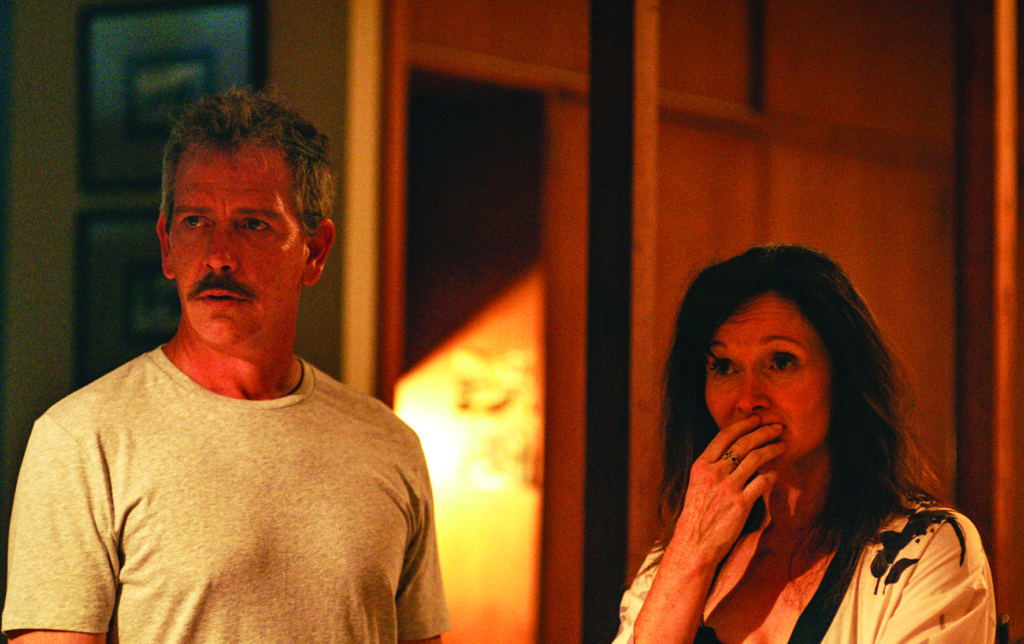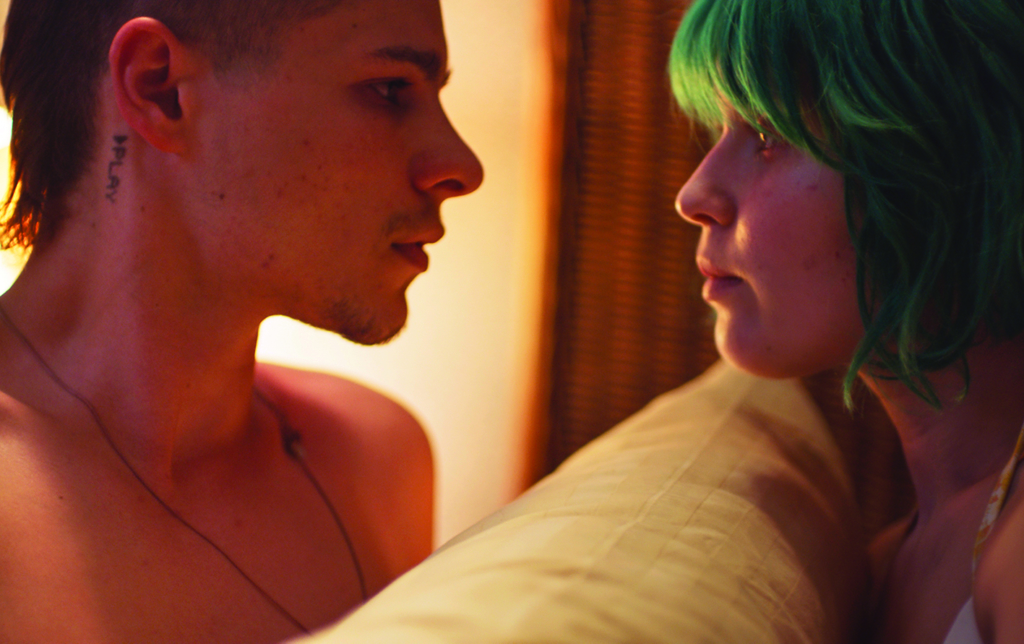At the movies, we like to watch girls die. How else do we account for the success of the slasher flick in which girls die left and right, and the one who survives only does so thanks to her extraordinary ‘ungirlishness’: her primness, her bookishness, her resourcefulness, her inability to attract the sexual attention of functional (read: non-psychotic) men? Elsewhere, girls die to prompt the hero’s journey of a lover, brother or father; they die to be a lesson someone else learns; they die so that others might truly live. Girls in corsets cough into handkerchiefs and delicately expire; girls, uncorseted, are found livid and mottled, dead in the woods – stark images to haunt investigators already teeming with personal demons. Or girls simply vanish and, gone those girls, leave behind a mystery in the cut-out shape of themselves. If there’s one thing the movies love as much as a dead girl, it’s a disappearing one – and, with its slow fade to black, the ‘Dying Girl’ movie gets to have both.

Rita Kalnejais adapted her own stage play into the screenplay for Shannon Murphy’s Babyteeth (2019), and it is frank, funny and foolhardy, admirably reckless in what it will risk to earn compassion for each of its flawed, frantic characters. But it is also a Dying Girl movie. It has a classic Dying Girl arc, as sixteen-year-old Milla Finlay (Eliza Scanlen) experiences the feverish flush of first love with 23-year-old livewire druggie Moses (an electrifying Toby Wallace) while going through the various stages of cosmetic, then finally critical, deterioration due to terminal cancer. In the background, waltzing into focus regularly, are her musician mother, Anna (beautifully played with brittle, Zoloft-addled grace by Essie Davis), and her stoically self-medicating psychiatrist father, Henry (in which role a brilliant Ben Mendelsohn can break your heart with his back turned).
As the film unfolds – because that is how it plays out, like the unfurling of a seemingly endless paper fortune teller, widening out in every direction with each new secret origami fold – supporting characters start to populate its fringes. (And beware: what follows is a spoiler-heavy discussion of how the film both hews to and eschews its subgeneric arc.) Milla’s beloved violin teacher Gidon (Eugene Gilfedder), who still carries a torch for Anna; Isaac (Zack Grech), Moses’ little brother whom his estranged mother has forbidden him to see; Toby (Emily Barclay), the Finlays’ new, heavily pregnant young neighbour with whom Henry becomes momentarily infatuated; even Tin Wah (Edward Lau), the truant schoolboy who starts hanging out at Gidon’s and shyly crushing on Milla.
At the movies, we like to watch girls die … If there’s one thing the movies love as much as a dead girl, it’s a disappearing one – and, with its slow fade to black, the ‘dying girl’ movie gets to have both.
But they all revolve around Milla – irritating, incandescent Milla; Milla, who has musical talent and a selection of wigs and cancer and one freakish baby tooth still in her jaw, played to artifice-eradicating perfection by Scanlen. After a brief stint on TV soap Home and Away, this Australian actor came to international recognition through the HBO miniseries Sharp Objects, a show littered with dead girls (and, oddly, with their teeth) in which Scanlen’s character, Amma, is also low-level dying throughout, kept sickly by the poison her deranged Munchausen Mama is gently, regretfully feeding her. Her follow-up role, in Greta Gerwig’s Little Women (2019), is as Beth, who must surely rank among literature’s foremost Dying Girls, and who, on the big and the small screen, has died at least sixteen times over since the first filmed adaptation in 1917. Wonderful as Gerwig’s visionary interpretation of many of those characters is, even she cannot – or does not – do much with Beth. Scanlen is good, but her purpose as Beth is what Beth’s purpose always is: to be saintly, to be sickly and to die, so that everyone in the film can miss her, without the audience ever missing her very much at all.
Whatever opportunities Little Women may squander with regard to the portrayal of its Dying Girl, Scanlen more than makes up for in Babyteeth. Seemingly a direct lineal descendant of terminal-illness romances like Josh Boone’s The Fault in Our Stars (2014), to name one of the best, and Nicole Kassell’s A Little Bit of Heaven (2011), to name one of the worst[1]Though you can find examples, like 1939 Bette Davis vehicle Dark Victory (Edmund Goulding), tracing all the way back to Hollywood’s Golden Age and beyond. , Murphy’s film – astonishingly, her debut feature[2]Murphy has, however, directed for beloved Australian TV series such as Offspring, Rake and Love Child. – exemplifies the category even as it thoroughly undermines and circumvents it.

If the subgenre’s half-century-old progenitor, Arthur Hiller’s Love Story (1970) – with its sticky, saccharine catchphrase ‘Love means never having to say you’re sorry’ – set the bar for terminal-illness romance, the swooning stop-start relationship between Milla and Moses matches it, minus the schmaltz: love, in Babyteeth, is full of apology, hesitation, misunderstanding and regret. And, if one of the most recent examples, Alfonso Gomez-Rejon’s Me and Earl and the Dying Girl (2015), seems loosely to play with the same sort of reflexivity that gives Babyteeth its vitality, it is notable just how much more sincere Murphy’s film feels. Me and Earl manages to be self-conscious without being self-aware, archly telegraphing the self-centredness of the narrative and the archetypes it employs, and even swiping at the sidelining of its as-yet-unnamed Dying Girl, all right there in the title. But then it proceeds to actually do all of those things, in the filmic equivalent of asking forgiveness in advance for sins that one cannot bear the mild inconvenience of simply not committing.
Babyteeth may also be reflexive, meta and, at times, arch, but it’s to paradoxically earnest, moving and emotive effect. Murphy, whose own background is in theatre, deploys a host of Brechtian cinematic techniques: fourth-wall breaking; text on screen; harshly edited, disruptive soundtrack cues that often play wildly, deliriously at odds with the mood of the visuals. But all of these supposedly ‘distancing’ trappings serve, somehow, to bring us into the story: they make us part of it, because they make us partially construct it, in a way more classical, less chaotic presentations seldom provide space for.
If the subgenre’s half-century-old progenitor, Arthur Hiller’s Love Story – with its sticky, saccharine catchphrase ‘Love means never having to say you’re sorry’ – set the bar for terminal-illness romance … love, in Babyteeth, is full of apology, Hesitation, misunderstanding and regret.
The tremendous soundtrack – eclectic and erudite, reflecting the musicality of Milla’s middle-class home, but also the vibrancy of the Sydney youth culture in which she’s dabbling as well as the loose-limbed 1970s-inflected pop, folk and soul that her parents’ generation grooved to – gives Murphy many clashing textures to work with. So we can triangulate a mood precisely between director of photography Andrew Commis’ sun-flared, popping daylights or his neony, glowing nighttimes and some choice, eternally surprising deep cut. Witness Milla, desperately disappointed in love, retreat to her cloistered bedroom to cry while a children’s choir version of raucous, jolly sea shanty ‘Santianna’ blasts out. Or the thrumming urban pop that accompanies Milla and Moses’ whirligig, illicit night on the town that crashes out in a strip-lit pharmacy, replaced by the tinny muzak piped through the store’s speakers. Or the quieter moment when Anna sits, head in hands, listening to classical radio and the soft-voiced DJ introduces Mozart’s Symphony No. 25, which plays out while Anna distractedly cleans leaves from the turquoise backyard pool. Mozart wrote this symphony – one of only two he set in a minor key – when he was seventeen[3]See Shari Mathias, ‘6 Interesting Facts About Mozart’s Symphony No. 25’, Parker Symphony Orchestra blog, 10 March 2019, <https://parkersymphony.org/about-mozart-symphony-no-25>, accessed 21 February 2020. , an age Milla is barely likely to reach; and it doesn’t matter if you know this or not, but Anna, a classical pianist herself, likely does. Whatever the case, there’s an unmistakable significance in the moment that obscurely informs this sense of a wider world that Murphy is so adept at creating – or at cuing us to create for ourselves.
Time and again, we’re reminded of the constructed nature of what we’re watching, of the storification process that is at work. Murphy has to know, for example, that the twenty-five-odd ‘chapter headings’ – ‘A Little Bit High’ announces one; ‘It Didn’t Feel Like a Love Story That Day’ toots another – are unnecessary for our understanding of the narrative. Instead, that these often overemphatic titles are patently not needed to explain things – ‘Romance (Part 1)’ reads the one that presages the first, um, romance montage – becomes the point of them. Like those interruptive soundtrack cues, they intrude and disrupt; they perform the opposite of a lullaby’s service in making us janglingly aware of the partial nature of what we’re seeing. Sometimes, they refer to a moment in the scene: ‘Are you sleeptalking?’ Anna asks Moses in the section marked ‘Sleeptalking’. Sometimes, they crib from a song cue: ‘Just Another Diamond Day’ flashes up as the song of that name, by 1970s English folk singer Vashti Bunyan, rings out. But, more often, they do neither; they just prod at us in pastel-coloured capitals to remember that we are only seeing fragments of a larger tapestry, that there are so many things happening elsewhere, in the gaps and caesuras between these segmented bursts of life. The off-screen lives of these characters become such unquestioned presences that, by the final act, we can hop suddenly into a party scene in which many previously damaged relationships seem suddenly mended, and yet its non-sequitur nature makes perfect sense. We don’t have to have seen these plot strands play out to understand that they occurred, and how, and why.

But maybe none of this would work half as well if we weren’t, at least a little bit, in Milla’s confidence. Murphy contrives to have Milla look straight out at us several times during the film, and, each time, it is an example of the film’s singular superpower – inviting us into its reality by making us aware of its artificiality – distilled into a glance. At first, these moments seem random, but, really, each tracks a different mood of Milla’s, charts a new point in her changing relationship to her life, to the world and to us, the living. The first look is one of panic after she collides with Moses – yet, given the dissociation of her quasi-suicidal state prior, it is a welcome jolt that reconnects her to the world. The next is after the disastrous meet-the-parents dinner during which we get the full-beam Fleabag-style ‘Isn’t he amazing?’ gaze. A couple more beats, a couple more looks. After Milla kisses Moses, she can’t help shooting us a boastful little ‘See what I did there?’ Then there’s a ‘Fuck this’ challenge, daring us to disapprove, while Milla becomes, for a long time, too busy falling in love to remember to include us at all.
And then there are the last two. ‘What the Dead Said to Milla’ reads the title of one of the shortest ‘chapters’. In it, Milla says nothing, does nothing. In her darkened room, she is listening to something we can’t hear and she can’t share; this time, her glance is soft, but it is retreating from us. A little later, she is outside on the lawn, listening to the ‘crazy’ birds at dawn, and her gaze floats past the camera in neutral, like we’re simply no longer of interest. This is, after all, a Dying Girl movie.

Does Milla really fall in love, or is it just a strange sort of transference? In that bleak moment on the platform when Moses brushes past her, is it just that, suddenly, the idea of a different type of self-eradication occurs to her – a different kind of surrender, to a love into which she can fling her whole self without embarrassment, because she can lose nothing by it? Then again, given that a kind of violence characterises almost all of her interactions with Moses, and given what she asks him to do in the end, is there any division in her mind between those two different kinds of surrender? It is part of the beauty of Babyteeth that we can ask these questions of Milla and not know the answers, along with all the other things we don’t know and were not shown but must have happened in there: hospitals, doctors, treatments, moments of agony. Murphy’s film is respectful of death – the awful intimacy of it, the privacy of it – in a way most terminal-illness movies are not. The cancer Milla suffers is her cross to bear, and the film makes no clumsy gesture towards shouldering some of that burden (or off-loading that burden onto us). This, finally, is how Babyteeth upends the central and most irksome trope of the Dying Girl film: by being about a girl who dies, not a death that is somehow, floatingly, attached to a girl. Murphy’s unusually bright, sensitive and, in time, devastating film lets Milla keep her death, her dying and her disease to herself. We only get everything else.
Endnotes
| 1 | Though you can find examples, like 1939 Bette Davis vehicle Dark Victory (Edmund Goulding), tracing all the way back to Hollywood’s Golden Age and beyond. |
|---|---|
| 2 | Murphy has, however, directed for beloved Australian TV series such as Offspring, Rake and Love Child. |
| 3 | See Shari Mathias, ‘6 Interesting Facts About Mozart’s Symphony No. 25’, Parker Symphony Orchestra blog, 10 March 2019, <https://parkersymphony.org/about-mozart-symphony-no-25>, accessed 21 February 2020. |





